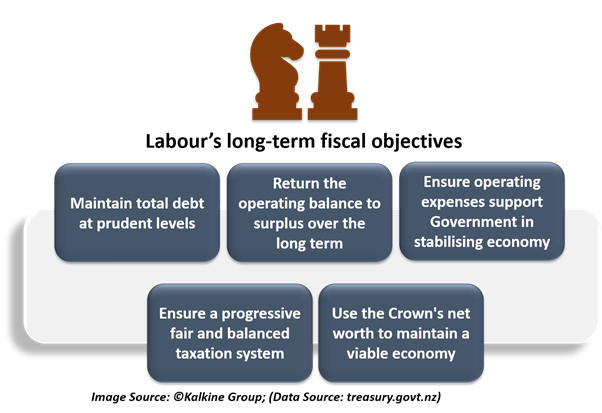Summary
- Labour released its fiscal plan on 1 October, with few changes apart from the new tax top tax rate of 39% on personal income earned above $180,000 announced earlier.
- The fiscal plan aims to manage books carefully, while reserving money to deal with coronavirus and safeguarding essential services like health and education.
- National Party has alleged a $10 billion gap in Labour’s financial plan stating that it did not include any provision for Auckland’s Light Rail and Pumped Hydro projects, as was promised by the party.
- However, Labour Party has taken both the projects into consideration as it has been evident since 2018 that it would leverage outside sources of capital for the Auckland’s Light Rail project, while funding has been set aside for Lake Onslow to carry out a business case.
On 1 October, Labour Party released its fiscal blueprint, making few changes to its fiscal plan, apart from the tax changes made earlier, with the party stating that it has reserved double the amount of money of what New Zealand National Party would tackle with essential cost burdens.
Labour announced a change in the income tax bracket with a new top tax rate of 39% on income earned above $180,000 in early September. However, the party pledged no fresh taxes or any additional rise in the income tax if it gets to serve another term.
ALSO READ: Election 2020: Labour to bring a 39% tax rate for top income earners
However, Labour updated a correction post releasing the fiscal plan, after it mislabelled an axis on a graph. The party stated that the slip had no effect on the overall budget and the numbers added up.
Labour’s fiscal plan
Finance Minister Grant Robertson described their fiscal strategy as a balanced one, which would prudently manage finances and maintain public services while countering coronavirus.
He also stated that while drafting the fiscal plan, Labour has ensured that enough money is available to cover essential services like health and education costs, while keeping debt under check.
ALSO READ: Lens over New Zealand Government debt, what does it mean for the NZD?
Some of Labour's fiscal goals for long-term period consists of the following:

Some of the highlights of the fiscal plan released by the Labour party includes the following:
- Labour plans to retain $12.1 billion in contingency expenditure for COVID-19, aiming at not spending the same for a quicker reduction in debt.
- The proposal assumes that adjustments in taxes on revenues and digital resources will add in $2.6 billion over four years that could be utilised above what was laid out in PREFU (Pre-Election Economic and Fiscal Update).
- Government books also include planned infrastructure investment of $42 billion over the next 4 years and money for more capital investment over 4 years ahead.
- The plan also mentioned more than $4.3 billion in new investments, leaving more than $21 billion for additional spending obligations or cost load items over 4 years.
Mr Robertson added that apart from other countries, NZ is also facing a 1 in century blow because of the coronavirus impact. Labour’s fiscal strategy provides for policies already revealed in the election campaign and also sets aside funds for contingencies, as well as policies that are due for the announcement.
Labour vowed to include 2 projects in its fiscal plan
The National Party asserted that Labour Party did not include the costing of its 2 expensive projects- pumped hydro and Auckland’s Light Rail project in transit to Auckland airport, in its fiscal plan.
On 10 September, Labour had unveiled plans to introduce the target of 100% renewable electricity by 5 years to 2030, with a review in 2025. Labour declared plans to invest $70 million in pumped hydrogen scheme at Lake Onslow, a renewable project that can address NZ’s dry year requirements.
Further, the Transport Minister, Phil Twyford gave confirmation in mid-September on delivering the Auckland’s Light Rail Project if Labour wins the election. The project was a promise made by the Labour party in their 2017 election campaign.
However, the project had to be dismissed in June due to lack of Cabinet’s approval.
National accused Labour of $10 billion fiscal gap
The National Party has accused Labour Party of a $10 billion fiscal hole in the economic plan.
Paul Goldsmith, National’s spokesperson, stated that there was an intentional exclusion of more than $10 billion relating to 2 of Labour’s most costly assurances.
He stated that pumped hydro had estimates beginning from $4 billion, and there had been no discussion on the same in Labour’s pamphlet. He asserted that Labour could not execute the policy target of reaching 100% renewable electricity by 2030, without a plan on its funding and implementation.
He also mentioned that Winston Peters (NZ’s First Leader) projected that Auckland’s Light Rail Project would cost at least $6 billion and as much as $15 billion, and there is no reference of the same by Labour in their pamphlet.
GOOD READ: Are There Any Green Shoots Sprouting in the NZ Economy?
He noted that Labour would not finance the Light Rail Project through National Land Transport Fund (NLTF) given that Robertson blamed National of ransacking NLTF to pay for some of the National’s personal transport package.
However, Labour denied such allegations. As per Robertson’s statement, the government has been clear since April 2018 that it would pull outside sources of capital for the project apart from the seed funding of $1.8 billion in the Auckland Transport Alignment Project, funded by the Auckland Council and NLTF.
Robertson’s office also stated that the government had reserved separate funding for Lake Onslow project to execute a business case.
(NOTE: Currency is reported in NZ Dollar unless stated otherwise)






